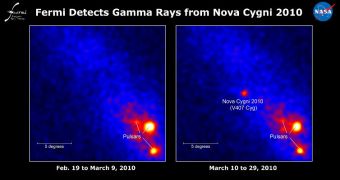In a groundbreaking new study, experts were able to determine that even nova explosions can cause the release of high-energy gamma-rays.
This type of emissions was previously thought to be reserved exclusively for supernova explosions, the death throes of massive stars several times more massive than the Sun.
Now, using the NASA Fermi Gamma-ray Space Telescope, astronomers at the American space agency's Goddard Space Flight Center, in Greenbelt, Maryland, managed to discover that this happens in lower-intensity nova explosions as well.
According to a NASA press release, the discovery “stunned observers and theorists alike,” as no one predicted that this type of event would even be possible.
Nova events, while extremely powerful in human terms, are rather inconspicuous cosmic events in which normal stars suddenly become brighter for a short period of time.
This generally happens in a binary system, where one of the stars accumulates mass from the other one until it reaches a certain threshold.
Once this level is achieved, the excess material is blasted away in a very massive thermonuclear explosion, which is the equivalent of thousands of times the energy our Sun emits ever year.
“But, compared to other cosmic events Fermi sees, [this nova] was quite modest. We're amazed that Fermi detected it so strongly,” says GSFC Fermi deputy project scientist Elizabeth Hays.
The new discovery began unfolding in Japan, when amateur astronomers Koichi Nishiyama and Fujio Kabashima, from the Saga Prefecture, discovered that the star V407 Cyg suddenly became brighter.
They had imaged the star on March 8, but the readings they collected on March 11 showed that the celestial object was about 10 times brighter than before.
Fermi's Large Area Telescope (LAT) then proceeded to investigate the phenomenon for about 15 days, and thus detected the gamma rays.
The finding is detailed in the August 13 issue of the esteemed journal Science. The shock wave that was produced following the nova explosion traveled away from the original site at around one million miles per hour, the study revealed.
“It takes thousands of years for supernova remnants to evolve, but with this nova we've watched the same kinds of changes over just a few days. We've gone from a photo album to a time-lapse movie,” says Kent Wood, from the Naval Research Laboratory (NRL), in Washington, D.C
Follow me on Twitter @TudorVieru

 14 DAY TRIAL //
14 DAY TRIAL //